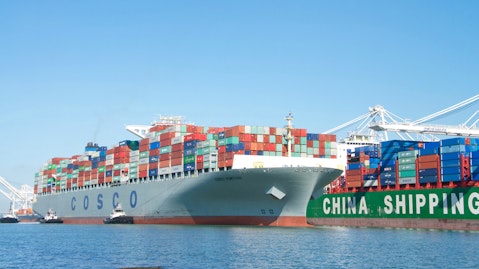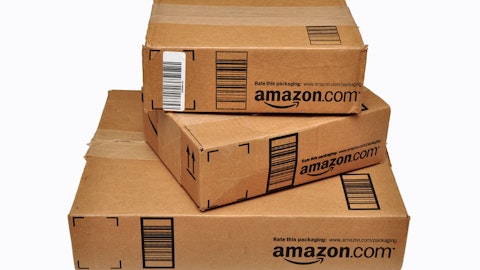Star Bulk Carriers Corp. (NASDAQ:SBLK) Q3 2022 Earnings Call Transcript November 17, 2022
Star Bulk Carriers Corp. misses on earnings expectations. Reported EPS is $1.33 EPS, expectations were $1.37.
Operator: Thank you for standing by, ladies and gentlemen, and welcome to the Star Bulk Carriers Conference Call on the Third Quarter 2022 Financial Results. We have with us Mr. Petros Pappas, Chief Executive Officer; Mr. Hamish Norton, President; Mr. Simos Spyrou; and Mr. Christos Begleris, Co-Chief Financial Officers; Mr. Nicos Rescos, Chief Operating Officer; and Mrs. Charis Plakantonaki, Chief Strategy Officer of the company. I must advise you that this conference is being recorded today. We now pass the floor to one of your speakers today, Mr. Spyrou, please go ahead, sir.
Simos Spyrou: Thank you, operator. I’m Simos Spyrou, Co-Chief Financial Officer of Star Bulk Carriers, and I would like to welcome you to our conference call regarding our financial results for the third quarter of 2022. Before we begin, I kindly ask you to take a moment to read the Safe Harbor statement on Slide #2 of our presentation. In today’s presentation, we will go through our Q3 results, cost evolution during the quarter, an overview of our balance sheet, an update on the fuel spread and vessel operations, the latest on the ESG front and our views on industry fundamentals before opening up for questions. Let us now turn to Slide #3 of the presentation for a summary of our third quarter 2022 highlights. Net income for the third quarter amounted to $109.7 million and adjusted net income of $136.3 million or $1.34 million per share adjusted earnings.

Sheila Fitzgerald/Shutterstock.com
Adjusted EBITDA was at $189.9 million for the quarter. For the third quarter, as per our existing dividend policy, we declared a dividend per share of $1.20 payable on or about December 12, 2022. The graph on the bottom of the page highlights the cumulative performance over the last 12 months, which illustrates the strength of the platform in a robust dry bulk market. Our last 12 months adjusted EBITDA is at $1.03 billion, and adjusted net income is at $819 million. Over the same period, we have returned a cumulative dividend of $6.50 per share or $670 million to our shareholders. On the top right of the page, you will see our daily figures per vessel for the quarter. Our time charter equivalent rate was at $24,365 per vessel per day. Our combined daily operating expenses and net cash G&A expenses per vessel per day amounted to $5,719 per day.
Therefore, our TCE less operating expenses, less G&A expenses stands at $18,646 per vessel per day. Our results for the third quarter of 2022 include a loss on write-down of inventories of $14.9 million, resulting from the valuation of the bunkers remaining on board of our vessels following the substantial decrease of the bunker’s net realizable value compared to their historical costs. We value our inventories at the lower between acquisition price and net realizable value. Usually, there is no such volatility in the value of the bunkers. However, on periods of continued decrease in bunker prices and to the extent the loss cannot be recovered we believe it is prudent to be recognized in earnings. Slide 4 graphically illustrates the cash flow bridge for the third quarter.
We started the quarter with a pro forma cash balance of $431 million and generated meaningful positive cash flow from operating activities of $184.5 million due to the strong commercial performance. After including debt repayments, CapEx payments for ballast water treatment systems, and the second quarter dividend payment, we are at the cash balance and cash equivalents of $392.7 million at the end of the third quarter. Slide No. 5 presents our fleet coverage for the next quarter. Looking at the fourth quarter of 2022, based on the latest pictures our fleet-wide coverage is at 66% of the available days at $22,772 per vessel per day. In terms of size segmentation, we have fixed 53% of our Capesize vessels at $26,328 per day, 76% of our post-Panamax comes from max vessels at $21,015 per vessel per day and 66% of our Ultramax/Supramax vessels at $22,462 per day per vessel.
Please turn now to Slide #6, where we highlight the continued strength of our balance sheet. Our pro forma total liquidity today stands at $417 million. Meanwhile, our total debt stands at approximately $1.36 billion. During the year, we have agreed refinancing totaling approximately $400 million that decreased our annual regular debt repayments by $12.5 million and reduced our interest costs by approximately $5 million per annum as a result of achieving significantly lower margins. Our next 12 months amortization is at $186 million. We have 13 unlevered vessels with market value of approximately $190 million and no debt maturities until 2024. In an increasing interest rate environment, we have interest rate swaps with an outstanding notional of approximately $755 million, fixed at an average rate of 46 basis points for an average remaining maturity of 1.4 years.
As of October 31, the mark-to-market value of these swaps was at $37.2 million.
Hamish Norton: Yes. And it’s Hamish Norton. Let me just interject the point here, which is that — it should be pretty obvious, if you look at our liquidity today, plus the FFA curve today, while anything can happen in the dry bulk market, this would imply a dividend for the fourth quarter that’s somewhat lower. Again, it’s just an obvious point. It will depend on how the FFA curve turns into reality over the next few weeks and months.
See also 25 Most Visited Countries in the World and 12 Biggest Metaverse Companies in the World.
Simos Spyrou : And I will now pass the floor to our COO, Nicos Rescos, to talk about our operational performance.
Nicos Rescos : Thank you, Simos. In Slide 7, we illustrate how Star Bulk is benefiting from a widening of the fuel spread between HSFO and VLSFO. We have 120 vessel scrubbers fitted on board with utilization having surpassed 116,000 operating days and average system availability of 99.5%. At the current Hi5 spread at healthy levels, our scrubbers meaningfully contribute to our profitability. The spread was defined during Q3 and currently hovers around $240 per metric ton versus Singapore prices where we gained approximately 60% of our annual fuel demand. Indicatively, the average Hi5 spread achieved during Q3 was $311 per metric ton. On the top right of the slide, we present a table that illustrates the impact that bunker benefit can have on our bottom line based on consumption of approximately 700,000 tons of HSFO per annum for our scrubber-fitted vessels.
Please turn to Slide 8, where we provide an operational update. Operating expenses, excluding nonrecurring expenses were at $4,769 per day per vessel for Q3 2022. Net cash G&A expenses was $950 per vessel per day for the same period. Despite continued adverse COVID-related expenses and inflationary pressures which have a direct impact on OpEx, the combination of our in-house management and the scale of the group enables us to sustain a very competitive cost base and maintain our position as the lowest cost operator amongst our peers. We expect our operating expenses to normalize during the fourth quarter. In addition, we continue to rate at the top amongst our listed peers in terms of Rightship safety score. Slide #9 provides a fleet snapshot and some guidance around future dry bulk and ballast water treatment installation expenses and the relevant total offhire days.
We are nearing the completion of our ballast water installation program with 98% of our fleet fitted with a system by the end of the fourth quarter this year. Our expected drive of expense for calendar 2023 is estimated at $19 million with a dry docking of 18 vessels, with another $2.3 million towards our vessel upgrade CapEx. In total, we expect to have approximately 520 offhire days for the same period. The above numbers are based on the current estimates around dry dock and retrofit planning, vessel employment and yard capacity. I’ll now hand the floor to our Chief Strategy Officer, Charis Plakantonaki, for an update on our ESG efforts.
Charis Plakantonaki: Thank you, Nicos. Please turn to Slide 10, where we highlight our latest actions on the ESG front. For a fourth consecutive year, Star Bulk established its annual report which provides transparent and comprehensive account of the company’s strategy, objectives and performance. The report has been prepared in accordance with the GRI Standards Core option, Sustainability Accounting Standards for Marine transportation, the NASDAQ ESG Reporting guidelines and the United Stations Global Compact principles. In disclosing the company’s progress on ESG-related key performance indicators, we have received limited external assurance from E&Y on specific GRI disclosures and SASB indicators. We have also engaged the company’s stakeholders, both internal and external, to identify and prioritize Star Bulk’s ESG certification as presented in the report.
On the people’s front, and following three years of the COVID-19 pandemic, the company is implementing an enhanced employee well-being plan, including flexible working schemes, mental health support, and employee engagement programs. I will now pass the floor to our CEO, Petros Papas, for a market update and his closing remarks.
Petros Pappas : Thank you, Charis. Please turn to Slide 11 for a brief update of supply. During the first 10 months of 2022, a total of 26 million deadweight was delivered and 3.6 million deadweight was sent to demolition for a net fleet growth of 22.4 million deadweight or 2.4% year-to-date and 2.8% year-over-year. The supply outlook continues to be the best we have seen in the recent history of dry bulk shipping. The order book has decreased to a record low of 6.9% of the fleet with just 16 million deadweight reported as firm orders year-to-date. Uncertainty on future propulsion along with high ship building costs and limited ship yard capacity until 2025, have helped keep new orders under control. Furthermore, scrap prices stand at elevated levels and could make demolition of overage and fuel-efficient tonnage an attractive — and fuel inefficient tonnage an attractive option during seasonal downturns.
We expect this to intensify as of 2023 forward when the EEXI-CII regulations will come into force. The average steaming speed of the dry bulk fleet has decreased by 5.3% year-over-year to 11.2 knots because of record high bunker costs and lower freight rates. We expect oil prices and subsequently bunker costs to remain inflated in the short to medium term with upcoming sanctions on Russian oil and the ongoing energy crisis. This situation, along with the new environmental regulations, will continue to incentivize slow steaming and inflate scrubber savings. Chinese port congestion has experienced a strong correction during the last two quarters as used arrivals helped debottleneck ports and easing of pandemic-related jurisdictions and ports.
Nevertheless, global congestion remains above pre-COVID levels, especially for smaller vessel types due to changes in trading patterns and seasonal bottlenecks. As a result of the above trends, net fleet growth is projected to end up at approximately 2.7% during 2022 and is unlikely to exceed 2% per annum between 2023 and 2025. Let’s now turn to Slide 12 for a brief update of demand. According to Clarksons, total dry bulk trade during 2022 is projected to contract by 0.5% in ton miles. Dry bulk trade this year has been affected by the war in Ukraine, the strong decrease of Chinese imports as the strict zero COVID policy continued to affect economic activity and weaker global economic outlook linked to surging commodity prices, a strong U.S. dollar, multi-decade high inflation and interest rate hikes.
During 2023, dry bulk demand is projected to increase by 1.4% in ton miles with the IMF forecast for global GDP growth presently standing at 2.7%. We believe that the relaxation of the strict zero COVID policy and gradual reopening of the Chinese economy will have a strong positive effect for the dry bulk market. Furthermore, increased restocking need worldwide and the shift of coal, grain and minor bulk trade patterns to longer haul routes should continue to benefit ton miles. Iron ore trade is expected to contract by 3.2% during 2022 and to increase marginally by 0.1% in 2023. During the first nine months of the year, crude steel production decreased by 3% in China and by 5% in the rest of the world due to negative profit margins, a strong drop of high energy-intensive electric arc furnaces and lower demand worldwide.
The Chinese steel industry has gone through a major slowdown since July 2021, driven by a weak real estate market, record high raw material prices and the strict zero COVID policy impact on economic activity during 2022. Nevertheless, over the last months, Chinese production has gradually recovered, while domestic iron ore output and stockpiles have decreased and provide a positive indicator for imports. Coal trade is expected to expand by 1.7% during 2022 and 2.8% in 2023. Global focus on energy security and high gas prices have upgraded the coal trade outlook for the next years. Moreover, sanctions on Russian coal by major importers and limited export capacity from Atlantic producers have pushed coal prices to record high levels over the last quarters.
European buyers are substituting imports from Russia with longer haul cargoes, while Russia is exporting more coal to China, India and other Asian countries, a situation that is benefiting ton miles. Throughout the year, China and India have increased their domestic production significantly in order to help raise stocks, reduce prices and be less dependent on imports. However, thermal electricity production is also growing at high pace, while stockpiles still stand at relatively low levels. Grain trade is expected to contract by 1.2% during 2022 and to expand by 4.3% during 2023. Over the last months, grain trade fundamentals have improved due to strong Brazilian corn exports and a partial resumption of Ukrainian exports on the back of the grain corridor agreement.
However, U.S. soybean export season continues with strong volumes and outstanding sales while a record high harvest is expected from Brazilian soybean farmers. Increased global focus on food security and a recovery of Ukrainian exports would support grain trade and ton miles of smaller sizes in the medium to long term. Minor bulk trade is expected to expand by 0.8% during 2022 and 0.7% in 2023. Minor bulk trade has the highest correlation to global GDP growth and the economic slowdown has affected trade volumes. Moreover, the correction of the container ship market is moderating the support that provided smaller geared vessels during 2021. On the other hand, shortages of steel products in the Atlantic and a positive price arbitrage continue to incentivize Pacific exports to the Atlantic.
Moreover, expanding West Africa bauxite to China continue to inflate ton miles with year-to-date exports up by 15%. Finally, our outlook for the dry bulk market remains positive, and our scrubber-fitted fleet is well positioned to take advantage. The record low order book combined with lack of yard space increased inefficiencies. Environmental regulations and high bunker costs create a favorable supply side picture for our industry. On the demand side, a gradual reopening of the Chinese economy increased infrastructure investments and changes of trade patterns to longer distances are expected to support earnings next year. Without taking any more of your time, I will now pass the floor over to the operator to answer any questions you may have.
Q&A Session
Follow Star Bulk Carriers Corp (NASDAQ:SBLK)
Follow Star Bulk Carriers Corp (NASDAQ:SBLK)
Operator: Our first question comes from the line of Amit Mehrotra with Deutsche Bank.
Amit Mehrotra : I wanted to start with acquisition opportunities. I think — if I think about the Star Bulk of today, a lot of the growth has really come actually at weaker points in the cycle where you’ve been able to attract sellers by the liquidity of the shares and in many cases, actually, those sellers have been willing to accept a price that’s far north of where the public equity is actually trading, which is pretty remarkable, I think it probably speaks to the strength of the platform. Are you seeing any opportunities like that? I know these deals are very difficult to come by, but you’ve done I think 58, 60 ships that way, which is a lot. And so I’d be curious if there’s a window of opportunity in what has been a tough tape for China, a tough tape for dry bulk in general. And recently, where you’re seeing maybe a window of opportunity to do additional deals like that, if you can just comment on that?
Hamish Norton : Yes. Sure, Amit. As you pointed out, we were very successful in closing a bunch of small M&A deals when the market was relatively weak. And then when the market got strong, it became hard to close these deals because the sellers had much higher expectations. If we go into a weak period in the market, and potential sellers get nervous, that could be very helpful and we might be able to close some deals. We’re not seeing anything right now. But these things come up without necessarily much warning and anything that we see we’ll pay a lot of attention to. We’re focused on trying to get good deals done in a weak market as much as a strong market.
Petros Pappas : Also — Amit, this is Petros. Also, I do not think we intend to order any new buildings going forward. They’re expensive. There’s deliveries for 2025. We don’t have a clear picture of where this is going as far as green fuels and new engines. And I assume we will not issue stock below net asset value to buy vessels.
Amit Mehrotra : And just a couple of more quick ones for me, if I could. So one is the stock has been pretty volatile and there was a moment there that you were getting a little bit more decent credit for the capital allocation strategy and the dividends that are actually sustainable. But now with the stock kind of back to quite a bit below NAV, I guess the question is — I’m just trying to get into your head a little bit, the commitment to the dividend strategy because there’s obviously a lot of uses for the capital, whether it’s even buying that stock, which you’ve done in the past a little bit. What’s the commitment level with the stock sort of languishing — hopefully temporarily at these levels?
Hamish Norton : Well, I mean Amit, you have no idea how stubborn we are. I mean, we’ve said it before, and we will continue to say it, and we will actually continue to say it until our face gets blue. We are committed to our dividend policy and it’s not just management who’s committed, but we have a large shareholding among the directors and the directors want their dividends. So I think you can count on that.
Amit Mehrotra : Yes. Last quick one for me. I think you might have mentioned the Simos, but with the refinancing, there obviously you — Christos has been quite busy doing that. Question is, what’s the — I know the debt amortization has come down a little bit. What is now the new kind of all-in breakeven? I think you might have mentioned in the script, but I might have missed it. It’s obviously below 10,500 or 11,000 that you can give us that new number?
Simos Spyrou: Amit, the breakevens are around 11,000 fleet-wide. And this includes also a provision for the dry docks as well.





